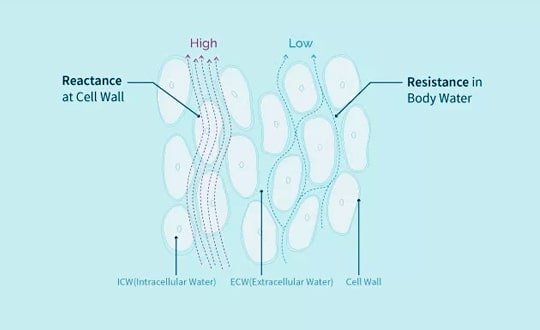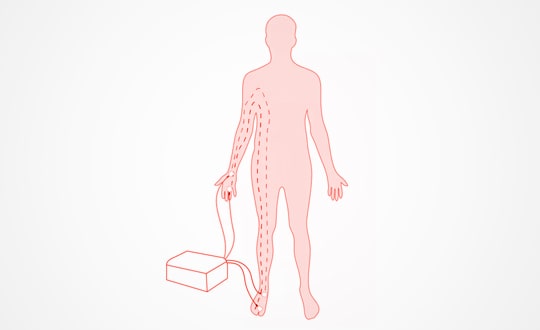
Tehnology
Learn more about body composition analysis and how InBody has improved existing BIA technology to provide accurate body composition analysis to professionals...
Bioelectrical Impedance Analysis (BIA) measures impedance by applying
alternating currents on the human body.
To better illustrate how this works, imagine the flow of cars in traffic. Your car is the voltage source or current, and the highway you’re on is body water. If there were no other cars, you could zoom past the highway, just as if the human body were full of body water and nothing else, there would be no resistance.
But water is not the only element in the human body, just like you’re not the only car on the freeway. As more cars get onto the freeway, the longer it takes for you to get through the path, creating resistance. Other elements such as fat, muscle, bone, and minerals create resistance to the electrical current that is going through your body.
In BIA, the more water that is in your body, the lesser the resistance. The muscle in your body contains water, unlike fat, so the more muscle you have, the more body water. And the more body water you have, the lesser the resistance on the electrical current


Reactance, also known as capacitive resistance, is the opposition to the instantaneous flow of electric current caused by capacitance. Reactance helps measure the cell’s ability to store energy and is an indirect measurement of cellular strength and integrity.
Impedance is the vector sum of resistance and reactance and is the measurement BIA devices use to determine your body composition. BIA applies a cylinder model for the relationship between impedance and a human body.
Impedance is calculated by using two formulas:
1. Calculating the volume of a cylinder (Volume = Length x Area) Characteristic of impedance: impedance is inversely proportional to cross-sectional area and directly proportional to length.
By knowing the impedance and the length of the cylinder, we can measure the volume of total body water.
In the human body, the same formula applies, where the length would be the height of the person. Therefore, we can calculate the volume of the total body water just by knowing the impedance and the height of individuals. This is also why it is imperative to have an accurate height measurement.

InBody’s medical-grade body composition analyzers rely on four pillars of
technology to give you extremely accurate and precise BIA results that
are highly correlated to gold-standard methods.
When measuring impedance with electrodes, contact resistance occurs. InBody accounts for contact resistance by strategically placing electrodes to accurately measure impedance in the body.
InBody provides independent measurements for each of the body’s 5 cylinders (left arm, right arm, left leg, right leg and the torso) to provide you accurate data.
InBody uses multiple currents at varying frequencies to provide the most precise body water analysis.
No empirical estimations are used to calculate your body composition. InBody measures your impedance independently, so your results are not affected by your age, ethnicity, or gender.

